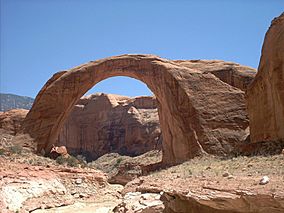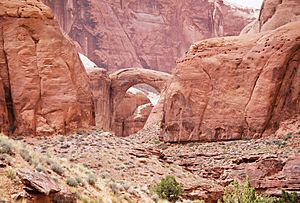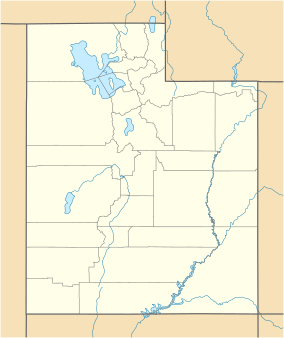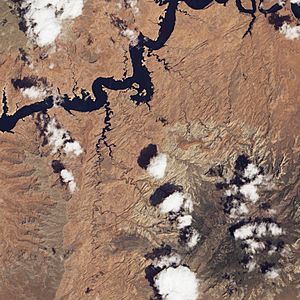Rainbow Bridge National Monument facts for kids
Quick facts for kids Rainbow Bridge National Monument |
|
|---|---|
|
IUCN Category III (Natural Monument)
|
|
 |
|
| Location | San Juan County, Utah, United States |
| Nearest city | Page, Arizona |
| Area | 160 acres (65 ha) |
| Created | May 30, 1910 |
| Visitors | 86,369 (in 2016) |
| Governing body | National Park Service |
| Website | Rainbow Bridge National Monument |
Rainbow Bridge National Monument is a special place in southern Utah, United States. It is managed by the Glen Canyon National Recreation Area. Many people say Rainbow Bridge is the world's tallest natural bridge.
The bridge is about 234 feet (71 meters) wide. At its top, it is 42 feet (13 meters) thick and 33 feet (10 meters) wide. This bridge is very important to several Native American tribes in the area. They consider it a sacred place. The National Park Service has named it a Traditional Cultural Property.
Contents
How Big is Rainbow Bridge?
Rainbow Bridge is very tall, reaching about 290 feet (88 meters) high. This makes it taller than some other famous arches in Utah, like Kolob Arch and Landscape Arch.
However, other natural arches around the world are even taller. For example, Aloba Arch in Chad is about 394 feet (120 meters) tall. The tallest known arch is Töshük Tagh, also called Shipton's Arch, in China. It is estimated to be around 1,200 feet (366 meters) high!
When it comes to width, Xianren Bridge (Fairy Bridge) in China is the widest natural bridge. It spans about 295 feet (90 meters).
Visiting Rainbow Bridge
Rainbow Bridge is one of the easiest large arches to visit. You can reach it by boat across Lake Powell. The boat ride takes about two hours from marinas near Page, Arizona. After the boat, it's a one-mile walk to the bridge.
You can also hike to the bridge. This overland trip takes several days. You need to get a permit from the Navajo Nation in Window Rock, Arizona first.
How Rainbow Bridge Formed

Rainbow Bridge is made of sandstone. This sandstone was once sand dunes, laid down by wind long ago. This happened during the end of the Triassic and Jurassic periods. The climate changed a lot back then. Sometimes it was a sea, and sometimes it was a desert like the Sahara. This created layers of sandstone with different hardness. Later, a sea covered these layers, pressing them tightly together.
Over time, during the last ice age, Bridge Creek flowed towards the Colorado River. The creek carved through softer rocks. It flowed around a hard "fin" of sandstone. This fin eventually became Rainbow Bridge. The old path of the creek can still be seen above the bridge.
Water flowing around bends creates swirling eddies. These eddies formed on both sides of the sandstone fin. They cut circular hollows into the rock. The sand and sediment in the creek slowly wore away the softer layers of sandstone. This left the harder layers behind, forming the amazing arch we see today.
History of Rainbow Bridge
Rainbow Bridge is located in rugged canyons near Navajo Mountain. Native Americans knew about it for centuries. They have always considered the bridge sacred. The Ancient Pueblo People lived here first. Later, Paiute and Navajo groups came. They called the bridge Nonnezoshe, which means "rainbow turned to stone." Some Native American families still live nearby.
In the 1800s, trappers, prospectors, and cowboys likely saw the bridge. But it wasn't until 1909 that the outside world learned about it. Two groups explored the area. One was led by Byron Cummings from the University of Utah. The other was led by government surveyor W.B. Douglass. They joined forces to find the legendary bridge.
Paiute guides Nasja Begay and Jim Mike led the way. Trader John Wetherill also joined them. On August 15, 1909, they saw Rainbow Bridge for the first time.
The next year, on May 30, 1910, U.S. President William Howard Taft declared Rainbow Bridge a National Monument. Early visitors included Theodore Roosevelt and writer Zane Grey. They traveled by foot and horseback to see it.
Over time, it became easier to visit. After World War II, people enjoyed river running in Glen Canyon. This made the bridge more accessible. By the early 1950s, people could travel by jet boat.
In 1956, the Glen Canyon Dam was approved. By 1963, the dam gates closed, and Lake Powell began to fill up. The rising water made it much easier for motorboats to reach Rainbow Bridge. This brought thousands of visitors each year.
In 1974, Navajo tribal members went to court. They wanted to protect sacred sites that were being covered by Lake Powell's rising waters. The court decided that water storage was more important. In 1980, another court ruled that closing a public site like Rainbow Bridge for religious ceremonies would go against the U.S. Constitution. This is because the Constitution protects everyone's religious freedom.
By 1993, the National Park Service created a new plan for the area. They talked with five Native American nations connected to Rainbow Bridge. These included the Navajo, Hopi, San Juan Southern Paiute, Kaibab Paiute, and White Mesa Ute. Their main concern was that Rainbow Bridge is a sacred place. They wanted visitors to treat it with respect. They also worried about people walking under the bridge.
Today, the National Park Service asks visitors to be respectful of Rainbow Bridge. It is important to the people who have held it sacred for a very long time. Visitors can still walk under the bridge along the creek bed. There is a path there that many people use.
Images for kids
See also
 In Spanish: Monumento nacional Puente del Arco Iris para niños
In Spanish: Monumento nacional Puente del Arco Iris para niños






